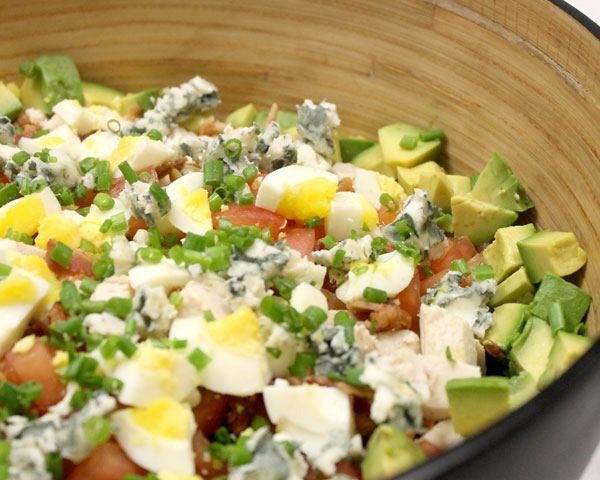The Ultimate Cobb Salad
I wish I had known enough to ask Bob Cobb for the real story behind the creation of his celebrated eponymous salad, back in the days when he used to come stand at our table at the Brown Derby in Beverly Hills and chat with my parents about mutual friends and recent parties. In those days, though, I had no idea what an iconic dish his salad was or would become, and I wouldn't have eaten it anyway. Too much weird stuff. Tomatoes, avocado, chives...
Click here to see The Ultimate Cobb Salad Recipe
The Brown Derbies, all four of them, were institutions in Los Angeles, from the time the first one opened in 1926, across the street from the Ambassador Hotel on the edge of downtown L.A. until the last surviving Derby, in Hollywood, closed after a fire in 1987. The idea for the place reportedly came out of a conversation late one evening between three friends: businessman Herbert K. Somborn (who was married to the screen siren Gloria Swanson), Sid Grauman (who owned the landmark Grauman's Chinese Theatre on Hollywood Boulevard), and Abe Frank, manager of the Ambassador Hotel. Discussing the dearth of good eating places in L.A. at the time, Somborn is said to have remarked "You could open a restaurant...in the shape of a hat and if the food and service were good the patrons would come flocking."
A year later, with investors including local department store moguls Tom and Wilbur May and movie studio boss Jack Warner, Somborn put his theory to the test: He opened a restaurant shaped like a gigantic brown derby hat, and dubbed it (what else?) The Brown Derby. An electric sign reading "Eat in the Hat" flashed over the place. The original menu was simple — chili, burgers, tamales, hot dogs. Gradually the menu grew, and so did the company. Samborn promoted one of his star employees, Robert H. Cobb, to be his second in command, and when Samborn died in 1934, Cobb became president of the Brown Derby Corporation. By then, the enterprise also included what was to become the most famous Brown Derby, on Vine Street in Hollywood, opened in 1929 (scenes from countless movies and early TV shows were shot there, and every Hollywood star you could name came in for lunch or dinner, and ended up with their caricatures on the walls), and the Beverly Hills branch, where we ate most often when I was young, oepned in 1931. Cobb later opened one more, on Los Feliz Boulevard in Hollywood, in 1940.
It was at the Vine Street outpost that Bob Cobb either first made the salad that was to bear his name, or had it made for him. The creation tale that makes the most sense is the one that has Cobb, closing the restaurant late one night and finding himself famished, throwing together whatever he could find in the walk-in (he may or may not have been hanging with Sid Grauman at the time). Other versions of the story credit the restaurant's chef with throwing it together one evening to feed Cobb, or with having created it by himself and naming it in honor of his boss.
Whatever its origins, by the time I became a regular Brown Derby customer with my parents, it had become one of the restaurant's most famous dishes. Although I didn't taste my first Cobb until I was in my late teens, I do remember seeing it served often, and it was a pretty thing: The Cobb was presented in a wide, shallow wooden bowl, its ingredients laid out in broad stripes, as if it were a kind of three-dimensional, edible flag. It was always tossed tableside, with what the Derby called "old-fashioned French dressing" (which was not that gloopy orange stuff, but basically a vinaigrette enhanced with garlic and Woprcestershire sauce). What I ultimately came to appreciate about it, when I started eating the salad, was the way it balanced colors and textures, and combined "healthy" stuff like different kinds of lettuce with treats like crumbled crispy bacon and little nuggets of Roquefort.
Bob Cobb died in 1970. The Brown Derbys are all gone from Los Angeles, though there is a replica of the Vine Street Derby at the Disney/Lake Buena Vista resort in Orlando. The salad, however, lives on.
Colman Andrews is the Editorial Director at The Daily Meal. Follow him on Twitter @colmanandrews.
